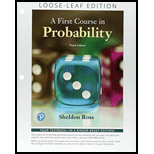
Concept explainers
For any real number y define by
Let c be a constant.
a. Show that
b. Find
Want to see the full answer?
Check out a sample textbook solution
Chapter 5 Solutions
FIRST COURSE IN PROBABILITY (LOOSELEAF)
- 1. Consider the following preference ballots: Number of voters Rankings 6 5 4 2 1st choice A DCB DC 2nd choice B B D 3rd choice DCBD 4th choice CA AAA For each of the four voting systems we have studied, determine who would win the election in each case. (Remember: For plurality with runoff, all but the top two vote-getters are simultaneously eliminated at the end of round 1.)arrow_forwarddangers of college kids carrying concealed handgunsarrow_forwardiid B1 Suppose X1, ..., Xn fx(x), where 2 fx(x) = x exp(−x²/0), 0<< (0 otherwise). (a) Find the maximum likelihood estimator of 0. (b) Show that the MLE is an unbiased estimator of 0. (c) Find the MSE of the MLE. Hint: For parts (b) and (c), you may use integration by parts.arrow_forward
- iid B1 Suppose X1, ..., Xn fx(x), where 2 fx(x) = x exp(−x²/0), 0<< (0 otherwise). (a) Find the maximum likelihood estimator of 0. (b) Show that the MLE is an unbiased estimator of 0. (c) Find the MSE of the MLE. Hint: For parts (b) and (c), you may use integration by parts.arrow_forward2) Suppose we select two values x and y independently from the uniform distribution on [0,1]. What is the probability that xyarrow_forward100 identical balls are rolling along a straight line. They all have speed equal to v, but some of them might move in opposite directions. When two of them collide they immediately switch their direction and keep the speed v. What is the maximum number of collisions that can happen? Let f(w) be a function of vector w Є RN, i.e. f(w) = 1+e Determine the first derivative and matrix of second derivatives off with respect to w. Let A Є RN*N be a symmetric, positive definite matrix and bЄ RN a vector. If x ER, evaluate the integral Z(A,b) = e¯xAx+bx dx as a function of A and b. John throws a fair die with faces labelled 1 to 6. ⚫ He gains 10 points if the die shows 1. ⚫ He gains 1 point if the die shows 2 or 4. • No points are allocated otherwise. Let X be the random variable describing John's gain at each throw. Determine the variance of X.arrow_forwardFemale Male Totals Less than High School Diploma 0.077 0.110 0.187 High School Diploma 0.154 0.201 0.355 Some College/University 0.141 0.129 0.270 College/University Graduate 0.092 0.096 0.188 Totals 0.464 0.536 1.000arrow_forwardFemale Male Totals Less than High School Diploma 0.077 0.110 0.187 High School Diploma 0.154 0.201 0.355 Some College/University 0.141 0.129 0.270 College/University Graduate 0.092 0.096 0.188 Totals 0.464 0.536 1.000arrow_forwardFemale Male Totals Less than High School Diploma 0.077 0.110 0.187 High School Diploma 0.154 0.201 0.355 Some College/University 0.141 0.129 0.270 College/University Graduate 0.092 0.096 0.188 Totals 0.464 0.536 1.000arrow_forwardFemale Male Totals Less than High School Diploma 0.077 0.110 0.187 High School Diploma 0.154 0.201 0.355 Some College/University 0.141 0.129 0.270 College/University Graduate 0.092 0.096 0.188 Totals 0.464 0.536 1.000arrow_forward6.54 Let Y₁, Y2,..., Y, be independent Poisson random variables with means 1, 2,..., An respectively. Find the a probability function of Y. b conditional probability function of Y₁, given that Y = m. Y₁ = m. c conditional probability function of Y₁+Y2, given that 6.55 Customers arrive at a department store checkout counter according to a Poisson distribution with a mean of 7 per hour. In a given two-hour period, what is the probability that 20 or more customers will arrive at the counter? 6.56 The length of time necessary to tune up a car is exponentially distributed with a mean of .5 hour. If two cars are waiting for a tune-up and the service times are independent, what is the probability that the total time for the two tune-ups will exceed 1.5 hours? [Hint: Recall the result of Example 6.12.] 6.57 Let Y, Y2,..., Y,, be independent random variables such that each Y, has a gamma distribution with parameters a, and B. That is, the distributions of the Y's might have different a's, but…arrow_forward6.82 6.83 6.84 6.85 *6.86 6.87 If Y is a continuous random variable and m is the median of the distribution, then m is such that P(Ym) = P(Y ≥ m) = 1/2. If Y₁, Y2,..., Y, are independent, exponentially dis- tributed random variables with mean ẞ and median m, Example 6.17 implies that Y(n) = max(Y₁, Y., Y) does not have an exponential distribution. Use the general form of FY() (y) to show that P(Y(n) > m) = 1 - (.5)". Refer to Exercise 6.82. If Y₁, Y2,..., Y,, is a random sample from any continuous distribution with mean m, what is P(Y(n) > m)? Refer to Exercise 6.26. The Weibull density function is given by -my" m-le-y/a f(y)= α 0. y > 0, elsewhere, where a and m are positive constants. If a random sample of size n is taken from a Weibull distributed population, find the distribution function and density function for Y(1) = min(Y1, Y2,Y). Does Y(1) = have a Weibull distribution? Let Y₁ and Y2 be independent and uniformly distributed over the interval (0, 1). Find P(2Y(1) 0, elsewhere,…arrow_forwardarrow_back_iosSEE MORE QUESTIONSarrow_forward_ios
 Big Ideas Math A Bridge To Success Algebra 1: Stu...AlgebraISBN:9781680331141Author:HOUGHTON MIFFLIN HARCOURTPublisher:Houghton Mifflin Harcourt
Big Ideas Math A Bridge To Success Algebra 1: Stu...AlgebraISBN:9781680331141Author:HOUGHTON MIFFLIN HARCOURTPublisher:Houghton Mifflin Harcourt Trigonometry (MindTap Course List)TrigonometryISBN:9781337278461Author:Ron LarsonPublisher:Cengage Learning
Trigonometry (MindTap Course List)TrigonometryISBN:9781337278461Author:Ron LarsonPublisher:Cengage Learning Algebra: Structure And Method, Book 1AlgebraISBN:9780395977224Author:Richard G. Brown, Mary P. Dolciani, Robert H. Sorgenfrey, William L. ColePublisher:McDougal Littell
Algebra: Structure And Method, Book 1AlgebraISBN:9780395977224Author:Richard G. Brown, Mary P. Dolciani, Robert H. Sorgenfrey, William L. ColePublisher:McDougal Littell- Algebra & Trigonometry with Analytic GeometryAlgebraISBN:9781133382119Author:SwokowskiPublisher:Cengage
 Glencoe Algebra 1, Student Edition, 9780079039897...AlgebraISBN:9780079039897Author:CarterPublisher:McGraw Hill
Glencoe Algebra 1, Student Edition, 9780079039897...AlgebraISBN:9780079039897Author:CarterPublisher:McGraw Hill





